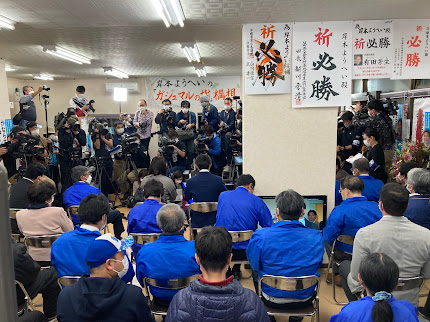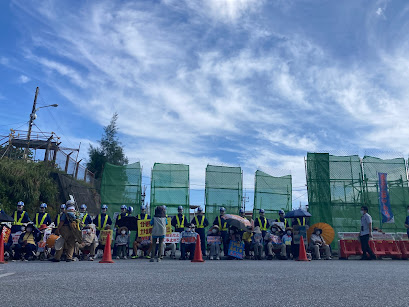A Note on the Nago Mayoral Election/名護市長選挙を振り返って
日本語は英語文の後にあります
Disappointing Result: Kishimoto Yohei Defeated by Toguchi Taketoyo
On January 23, 2022, in a closely watched Nago mayoral election, the incumbent mayor Toguchi Taketoyo defeated Kishimoto Kohei (former Nago city assembly representative). With a 68 percent voter turnout rate, Toguchi gathered 19,524 votes, while Kishimoto gained 14,439 votes. Toguchi has secured his second term in the Nago mayor's office.
As a Nago citizen and an environment NGO member, I was disappointed with the result and surprised by the wide margin.
I rooted for Kishimoto because, among other things, he showed his firm stance against the construction of a U.S. military at Henoko-Oura Bay on the city's east coast as the replacement facility for Futenma Air Station in Ginowan City. In contrast, Toguchi took a mimamoru (見守る) stance: He would "keep his eyes" on how the dispute over the Henoko issue between the Okinawa prefectural government and the Japanese government would be resolved in court. In other words, as he did during the last 4 years as Nago mayor, he remained silent on the issue during this election. The Henoko issue has affected the lives of the citizens of Nago City for the last 25 years and will continue to do so in the foreseeable future. It was my firm belief that candidates for Nago mayor should address the issue head-on, whether for or against it. Silence favors the Japanese government.
Why Toguchi Prevailed
I understand why Toguchi prevailed, however. First, over the last 25 years, Nago citizens have experienced and witnessed how the Japanese government can crush democratic voice expressed in elections and referendums against the Henoko plan. The oppression started in 1997 when, under pressure from the Japanese government, then Nago mayor Higa Tetsuya accepted the government's proposal to build a base on the east coast of Nago, overturning the result of the Nago city referendum. The permeating fatalistic view, "we cannot do much about Henoko," was the backdrop against which Nago elections, including this one, have been held.
Second, Toguchi's election promises, such as free school lunch and free medical care for children, were more convincing than those of Kishimoto's. Except for their positions on the Henoko issue; the two candidates' election promises were very similar. However, Toguchi's promises had the strong backing of the Japanese government. Indeed, during Toguchi's first four years as Nago mayor, the Japanese government provided financial support for his policies (for his silence on the Henoko issue). Toguchi talked about his achievements, while Kishimoto talked about promises and hopes.
Third, Toguchi's election campaign was well organized and well run, backed up by the Japanese government and LDP and Komeito campaigners. His campaigners were able to visit local businesses and homes, securing votes even before Kishimoto's campaign started. Also, many voters quickly noticed that the quality of paper used in Toguchi's campaign flyers was much better than those of Kishimoto's flyers, telling of the monetary power of Toguchi's campaign.
 |
| Toguchi's election campaign flyer |
Finally, Toguchi kept his silence on the Henoko issue. For many who oppose the construction, his silence was equivalent to relinquishing the mayor's responsibility, especially regarding local self-governance. However, for many Nago voters, Toguchi's mimamoru stance provided an ironic space of vindication. They could vote for Toguchi for his promises of free school lunch and free medical care for children but still opposed the Henoko base construction. They could claim that their votes for Toguchi did not mean their approval for the base construction since Toguchi remained silent on the issue. They could insist that the Nago mayoral election was not where the base issue was discussed. Indeed, according to a NHK exit poll, 65 percent of the Nago citizens who casted their votes opposed the Henoko base construction. In other words, 39 percent of the voters who favored Toguchi opposed the Henoko base construction. Nonetheless, Toguchi's mimamoru strategy worked well to bring him a victory.
Moving Forward
As expected, some LDP members quickly equated Toguchi's victory to the Nago people's approval of the Henoko base construction. However, Toguchi knows well that he won in part by not declaring his position on the Henoko issue. He has to wait for other parts of the Japanese government's scenario "the Henoko is the only solution for Futenma" to be played out before he could move on to declare his support for the construction.
Nago citizens are desperately seeking an arena where the issue of Henoko base construction can be brought up and examined on the principles of democracy, justice, rule of law, genuine security, and environmental protection. Many are convinced that there is accumulating evidence that the Japanese government's mantra "Henoko is the only solution" cannot hold. The presence of fragile seafloor found at the construction site has pushed the completion of base construction to 2030s at the earliest, and it has cast serious doubt on the feasibility of the construction plan. The construction work has already created environmental tragedies. The continuing and immediate dangers of Futenma, such as falling objects from aircraft, PFAS/PFOS contaminated land and water, and thunderous noise from aircraft day and night, all indicate that Futenma is a ticking time bomb. In other words, Futenma cannot wait for Henoko.
As a Nago citizen and an environment NGO member, I am determined. Together with other Nago citizens and civil society members worldwide, we keep taking the Henoko issue to the international society and there we continue our fight fair and square and win.
Hideki Yoshikawa
Director
Okinawa Environmental Justice Project
名護市長選挙を振り返って(オリジナルが英文なのでリンクも英文記事へのリンクになっています)
残念な結果:岸本洋平氏、渡具地武豊氏に敗れる
2022年1月23日、注目された名護市長選挙において、現職の渡具地武豊氏が新人の岸本洋平氏(前名護市議会議員)を破り当選した。投票率は68.32 パーセントで、渡具地氏が19.524票、岸本氏が14,439票を集めた。これで渡具地氏は名護市長として二期目を勤めることになる。
名護市民としてそして環境NGOのメンバーとして、私は選挙の結果を非常に残念に思い、また得票差に驚いている。
私は岸本氏を応援していた。応援の理由は幾つかあるが、最も大きな理由は、普天間飛行場の代替施設として名護市東海岸の辺野古・大浦湾において進められている米軍新基地建設に、彼は断固として反対していたからだ。一方渡具地氏は、辺野古新基地建設問題に対して、沖縄県と日本政府の裁判での経過を「見守る」という立場をとっていた。すなわち、沈黙していた。辺野古新基地建設問題は、過去25年に渡り名護市民の生活に大きな影響を与えてきたし、今後も与え続けていくであろう。そのような重要な問題には、名護市長選挙の候補者は賛成であれ反対であれ立場を表明すべきだ、というのが私の立場だ。沈黙は日本政府を有利にする。
渡具地氏の勝利の理由
渡具地氏の勝利の理由を私は以下のように理解している。 第一の理由は、選挙や住民投票で示されてきた辺野古新基地建設反対の民意を日本政府がいかに無視し、そして潰してきたかを名護市民は身を持って経験してきことだ。政府の圧力は1997年に始まった。名護市東海岸への普天間の建設計画について市民が住民投票で示した反対の民意を、日本政府の圧力の下、当時の比嘉鉄也市長が覆し、政府の計画を受け入れた。これまでの選挙同様、今回の市長選挙も「辺野古について市民ができることはない」という諦めの態度を背景に行われた。
第二の理由は、学校給食費やこどもの医療費の無料化という渡具地氏の政策のほうが岸本氏の政策より、より現実味があったことだ。辺野古新基地建設問題を除き、二人の候補者の政策は非常に似通ったものであった。しかし渡具地氏の政策は日本政府の協力な後ろ盾があった。実際過去4年間の間、日本政府は辺野古問題への沈黙と引き換えるように渡具地氏の政策を財政的に支えてきた。渡具地氏がこれまでの成果を語れたのに対し、岸本氏が語れたのは約束や希望であった。
第三の理由は、渡具地氏の選挙運動が日本政府や自民党や公明党の運動員の支援を受け、うまく組織化され、展開されていたことだ。岸本氏の選対が動き出す前に、渡具地氏の選対は、企業や家々を訪問していた。また、選挙応援ビラで使われた紙の質も渡具地氏側のほうが良く、渡具地氏選対の財政的力を名護市民は嫌がおうでも感じていた。
そして第四の理由は、渡具地氏が辺野古新基地建設問題について沈黙していたことだ。新基地建設に反対する人々にとって彼の沈黙は、市長としての地方自治への責任放棄として写っていた。しかし多くの有権者にとっては、彼の「見守る」という態度は、自らの投票行動の弁明を可能にするものであった。つまり、渡具地氏の学校給食費やこどもの医療費の無料化という政策を支持しながらも、新基地建設には反対するという立場を可能にしたのだ。渡具地氏への自分の投票は基地の容認ではない、なぜなら渡具地氏は新基地建設に対して何も言っていない。名護市長選挙自体が、新基地問題を議論する場ではなかった、との主張を可能にしたのだ。実際、NHKの出口調査によると、投票者の約65パーセントが辺野古新基地建設には反対していた。言い換えると、渡具地氏に投票した人の39パーセントが新基地建設には反対しているのだ。いずれにせよ、渡具地氏の「見守る」戦略は渡具地氏に勝利をもたらしたことに変わりはない。
これからの動き:名護市民として環境NGOとして
予想された通り、自民党支持者のなかには渡具地氏の勝利を名護市民による辺野古新基地建設の容認だと解釈するものもいた。しかし渡具地氏自身にも明白なように、彼の勝利は辺野古問題に言及しなかったことにも関係している。渡具地氏が辺野古新基地建設容認を表明するには、辺野古が普天間の「唯一の解決策」という日本政府の主張が内含する問題の解決が不可欠だ。しかし果たしてそれは可能であろうか。
名護市民は、民主主義、法の遵守、真の安全保障、正義、そして環境保護の原則に基づいて、辺野古新基地建設問題が検証され、判断されることを求めている。そして多くの市民が、日本政府の「辺野古が唯一」のシナリオが成り立たないことを確信し始めている。埋め立て地で見つかった軟弱地盤の問題は、基地の完成を2030年中頃へと変更させ、工事実現の可能性をも疑問視させている。工事はすでに環境破壊の悲劇を生み出している。一方、航空機からの落下物、PFAS/PFOSに汚染された土壌や水、昼夜構わず鳴り響く航空機爆音という普天間の危険性は続き、普天間は時限爆弾化しているともいえる。すなわち、普天間飛行場の危険除去は辺野古新基地の完成を待てないのだ。
名護市民としてそして環境NGOのメンバーとして私は決意している。名護市民そして国際市民社会のメンバーとともに、辺野古新基地問題を国際社会に問い続け、公明正大に検証させ、そして勝利していくことを。
Okinawa Environmental Justice Project
代表 吉川秀樹



